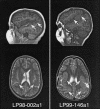A locus for bilateral perisylvian polymicrogyria maps to Xq28
- PMID: 11822025
- PMCID: PMC379093
- DOI: 10.1086/339433
A locus for bilateral perisylvian polymicrogyria maps to Xq28
Abstract
Polymicrogyria (PMG) is one of a large group of human cortical malformations that collectively account for a significant percentage of patients with epilepsy, congenital neurological deficits, and intellectual disability. PMG is characterized by an excess of small gyri and abnormal cortical lamination. The most common distribution is bilateral, symmetrical, and maximal, in the region surrounding the sylvian fissures, and is known as "bilateral perisylvian polymicrogyria" (BPP). Most cases are sporadic, although several families have been observed with multiple affected members, usually following an X-linked inheritance pattern. Here we report the first genetic locus for BPP mapped by linkage analysis in five families. Linkage places the critical region for BPP at Xq28 (LOD score 3.08 in Xq28, distal to DXS8103 by multipoint analysis). We suggest that this region contains a gene that is necessary for correct neuronal organization and that the identification of this gene will both enhance our understanding of normal cortical development and accelerate the identification of other genes responsible for PMG.
Figures




References
Electronic-Database Information
-
- Online Mendelian Inheritance in Man (OMIM), http://www.ncbi.nlm.nih.gov/Omim/ (for BPP [MIM 260980])
References
-
- Baker EM, Khorasgani MG, Gardner-Medwin D, Gholkar A, Griffiths PD (1996) Arthrogryposis multiplex congenita and bilateral parietal polymicrogyria in association with the intrauterine death of a twin. Neuropediatrics 27:54–56 - PubMed
-
- Borgatti R, Triulzi F, Zucca C, Piccinelli P, Balottin U, Carrozzo R, Guerrini R (1999) Bilateral perisylvian polymicrogyria in three generations. Neurology 52:1910–1913 - PubMed
-
- Crome L (1952) Microgyria. J Pathol Bacteriol 64:479–495 - PubMed
MeSH terms
Associated data
- Actions
LinkOut - more resources
Full Text Sources
Medical
Molecular Biology Databases

